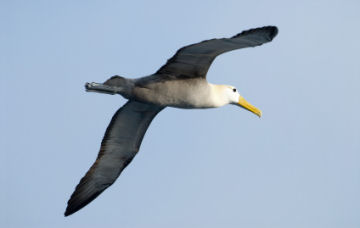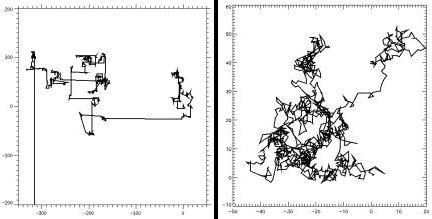Flying without Fractals
A new study raises doubts about fractal patterns in animal behavior
- More than 2 years ago
Scientific fashions can rise and fall, like the hems of each year’s skirts. Unlike haute couture, however, scientific fads can shed light on the world.


Fractals have been in fashion for a couple of decades or so, and researchers have been finding fractal-based patterns in the ways that many animals search for food. Albatrosses, deer, and bumblebees are among the growing array of animals with fractal-based search patterns. But a new study has found flaws in the methodology used in all such animal studies, raising questions about whether fractal search patterns really do occur in animal behavior.
Wandering albatrosses were the first animal studied that seemed to use fractal search techniques. In 1996, Gandhimohan M. Viswanathan of Boston University and his colleagues clipped recording devices to the legs of albatrosses to track when the birds were in the water and when they were not. The researchers figured that the birds were resting or feeding when wet and flying when dry.
Most of the time, the albatrosses flew short distances, as the researchers had expected. But sometimes, they flew very far indeed. On rare occasions, the data showed, the birds would fly for as long as 96 hours. The pattern formed by frequent short journeys, less frequent longer journeys and rare very long journeys is known as a “Lévy flight.”
These very long journeys are the critical element that distinguishes Lévy flights from other, more common statistical patterns. By contrast, a speck of dust would never leap to the other side of a room in its random jostlings, so its motion wouldn’t form a Lévy flight.
Lévy flights are the statistical fingerprint of a fractal. If the albatross’s travels form a Lévy flight, a graph of it would show connected clumps, and these clumps would be made up of smaller clumps, which in turn would be made up of still smaller clumps. If it were a perfect fractal, this pattern would continue forever like an infinite set of Russian dolls. In nature, it can only continue for a few steps.
At the time, the researchers weren’t sure why the birds would fly in that particular pattern. They thought perhaps food was distributed on the ocean in similar clumps. But a few years later, Viswanathan and his colleagues showed that Lévy flights provide the best strategy in searching for objects at random locations. This suggested that the bird’s behavior has adaptive value. “If I lost my child in the woods, the best way to find my child would be to do a search with Lévy flight motion,” says H. Eugene Stanley of Boston University, a co-author on all of the studies. “A simple random walk retraces its same sites over and over and over again.”
Soon, Viswanathan’s team and other researchers found similar behavior in reindeer, spider monkeys, bumblebees, zooplankton, and jackals. The research on jackals was especially important because jackals can spread rabies. If they travel in Lévy flights, that would mean they could spread rabies quickly over long distances.
In the decade since the original albatross study, animal tracking methods and statistical methods have both improved. So Andrew M. Edwards of the British Antarctic Survey collaborated with Viswanathan and his colleagues to revisit the albatross study and see if it still stands up. They found that it doesn’t.
The researchers started by analyzing recent data from tracking albatrosses, which includes GPS data. From the new data, they found that the albatrosses weren’t taking the very long flights at all. So they reexamined the old data to work out the discrepancy and discovered that the albatrosses weren’t necessarily flying whenever they weren’t in the water. They also spent time sitting on their nests. So, the animals’ longest dry periods don’t correspond to very long journeys after all.
Next, the researchers turned to their studies of other animals. The data on deer foraging had a problem similar to the issue with the albatross data, and the bumblebee data didn’t stand up to stricter statistical scrutiny.
Stanley says the original study was valuable even though it turned out to be wrong. “Niels Bohr got a Nobel Prize for the Bohr atom,” he says, “but his theory is absolute rubbish. The truth is much more complicated and less poetic. But Bohr’s atom theory was very important nonetheless,” because it was a step that led to the more sophisticated theories. The development of the theory of Lévy flights in animal behavior is following a similar trajectory, he says.
Frederic Bartumeus of Princeton University says he’s not surprised to find out that some of the old studies were flawed. “They’re showing that we have to be careful how we analyze data to say that we definitely have these Lévy flight patterns, and that’s good,” he says. “But that doesn’t mean there are no Lévy flights in nature.”
Indeed, many researchers are continuing to study a variety of animals, from honeybees to humans. Bartumeus and others are optimistic that some of these animals will be rigorously shown to exhibit Lévy flight behavior. Viswanathan himself shares the optimism, but “the jury is still out,” he says.
If you would like to comment on this article, please see the blog version.






